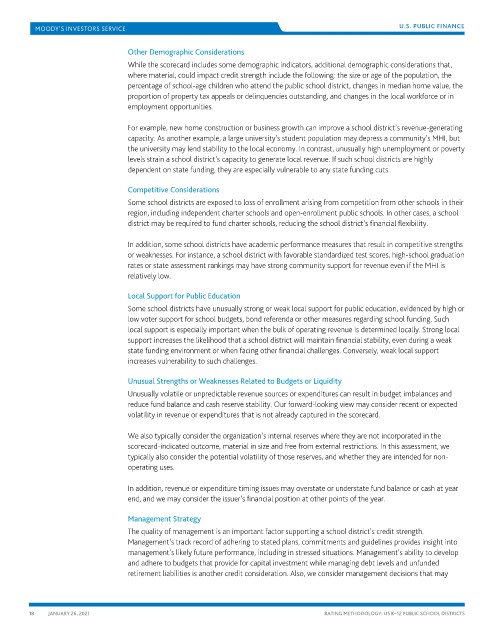Page 1652 - draft
P. 1652
U.S. PUBLIC FINANCE
Other Demographic Considerations
While the scorecard includes some demographic indicators, additional demographic considerations that,
where material, could impact credit strength include the following: the size or age of the population, the
percentage of school-age children who attend the public school district, changes in median home value, the
proportion of property tax appeals or delinquencies outstanding, and changes in the local workforce or in
employment opportunities.
For example, new home construction or business growth can improve a school district’s revenue-generating
capacity. As another example, a large university’s student population may depress a community’s MHI, but
the university may lend stability to the local economy. In contrast, unusually high unemployment or poverty
levels strain a school district’s capacity to generate local revenue. If such school districts are highly
dependent on state funding, they are especially vulnerable to any state funding cuts.
Competitive Considerations
Some school districts are exposed to loss of enrollment arising from competition from other schools in their
region, including independent charter schools and open-enrollment public schools. In other cases, a school
district may be required to fund charter schools, reducing the school district’s financial flexibility.
In addition, some school districts have academic performance measures that result in competitive strengths
or weaknesses. For instance, a school district with favorable standardized test scores, high-school graduation
rates or state assessment rankings may have strong community support for revenue even if the MHI is
relatively low.
Local Support for Public Education
Some school districts have unusually strong or weak local support for public education, evidenced by high or
low voter support for school budgets, bond referenda or other measures regarding school funding. Such
local support is especially important when the bulk of operating revenue is determined locally. Strong local
support increases the likelihood that a school district will maintain financial stability, even during a weak
state funding environment or when facing other financial challenges. Conversely, weak local support
increases vulnerability to such challenges.
Unusual Strengths or Weaknesses Related to Budgets or Liquidity
Unusually volatile or unpredictable revenue sources or expenditures can result in budget imbalances and
reduce fund balance and cash reserve stability. Our forward-looking view may consider recent or expected
volatility in revenue or expenditures that is not already captured in the scorecard.
We also typically consider the organization’s internal reserves where they are not incorporated in the
scorecard-indicated outcome, material in size and free from external restrictions. In this assessment, we
typically also consider the potential volatility of those reserves, and whether they are intended for non-
operating uses.
In addition, revenue or expenditure timing issues may overstate or understate fund balance or cash at year
end, and we may consider the issuer’s financial position at other points of the year.
Management Strategy
The quality of management is an important factor supporting a school district’s credit strength.
Management’s track record of adhering to stated plans, commitments and guidelines provides insight into
management’s likely future performance, including in stressed situations. Management’s ability to develop
and adhere to budgets that provide for capital investment while managing debt levels and unfunded
retirement liabilities is another credit consideration. Also, we consider management decisions that may
18 JANUARY 26, 2021 RATING METHODOLOGY: US K–12 PUBLIC SCHOOL DISTRICTS

